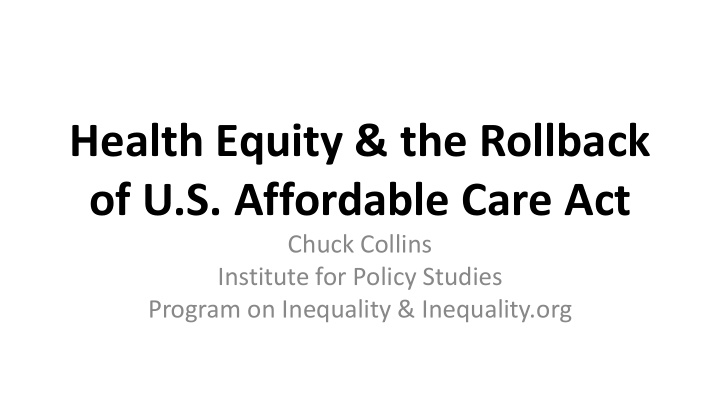



Health Equity & the Rollback of U.S. Affordable Care Act Chuck Collins Institute for Policy Studies Program on Inequality & Inequality.org
Institute for Policy Studies Program on Inequality • Partner with grassroots and policy organizations • Publicize research and analysis: Inequality.org • Elevate stories of activists • Conduct in-depth original research • Disrupt the narratives that perpetuate inequality
Health Equity: A Definition Everyone has a fair and just opportunity to be as healthy as possible. This requires removing obstacles to health such as poverty, discrimination, and their consequences, including powerlessness and lack of access to good jobs with fair pay, quality education and housing, safe environments, and health care.
Measuring Health Equity reducing and ultimately eliminating disparities in health and its determinants that adversely affect excluded or marginalized groups.
U.S. Stumbling Toward Universal Health Care
A Long Road • 1965 Medicare and Medicaid – Medicare is universal for those over 65 or with disabilities – Medicaid is for low income households, jointly implemented with states • 1993 Pres. Bill Clinton attempt
Aff ordable Care Act (“ Obamacare ”) Passed October 2009 Implemented 2012
Key Provisions of Affordable Care Act • Protections : Cover pre-existing conditions at affordable rates • Young adults remain on parent’s plans until 26 • Mandate – penalty for not having insurance • Expansion of Medicaid at state levels • Subsidies for care paid for by 3 taxes, including tax on medical equipment, surcharge on high incomes.
Forward movement under “ Obamacare ” • In 4 years -expanded coverage by additional 17 million people • 29 million remain uninsured – more underinsured • Health equity – Beginning to make a difference • 31 states and District of Columbia adopt ACA Medicaid funds, expanding coverage
States Adopting ACA Medicare
Health Equity Example: African-American families • Under ACA, between 2013 and 2016, the uninsured rate for nonelderly African Americans declined from 18.9 percent to 11.7 percent. • White uninsured rate is 7.5 percent • African Americans make up 13.3 percent of U.S. population but 19 percent of Medicaid enrollees • Repeal of ACA and cutting Medicaid would risk this progress.
Backlash against Affordable Care Act
“A government takeover of health care system”
American Health Care Act “ Trumpcare ” • Phases Out ACA’s Medicaid expansion • Caps federal payments to states for Medicaid • Elimination of ACA “mandate penalties” with surcharge on people who fail to maintain coverage. • Other provisions that shift costs/risks to consumer • Repeal of taxes to pay for ACA provisions
House Plan: 23 Million Uninsured by 2026
Repeal of ACA is Driven by Tax Cut Agenda
Scenario A: Political Gridlock
States won by Donald Trump
Many Red States with Medicaid Expansion: Alaska, Arizona, Idaho, Montana, North Dakota, Wisconsin, Michigan, Iowa, Indiana, Ohio, Kentucky, West Virginia, Pennsylvania, Arkansas, Louisiana RED: Trump States
Confusion over ACA vs. Obamacare
Trump Vote in Michigan
Michigan: 1 in 10 depend on ACA, Mostly in Counties that Supported Trump
Scenario B: Reversal-Rise in Health Disparities
Future Trend: Polarization of States: Health Equity vs. Disparity
California “Single payer” Proposal passes in May 2017
Pressure Builds for “Medicare for All”
Sander’s Proposal – Paid for by Progressive Revenue provisions
Visit the newly rebooted www.inequality.org
Recommend
More recommend